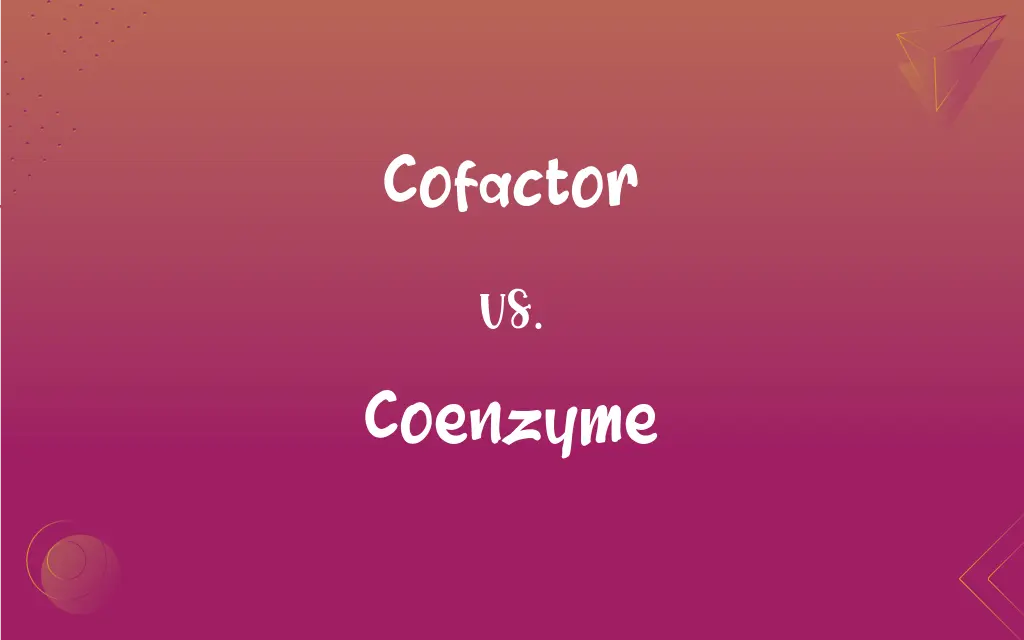Cofactor vs. Coenzyme: What's the Difference?
Edited by Janet White || By Harlon Moss || Updated on October 17, 2023
Cofactors are non-protein chemical compounds required for an enzyme's activity, while coenzymes are organic molecules that temporarily bind to enzymes and assist in substrate conversion.

Key Differences
A cofactor is a non-protein chemical compound that binds with an enzyme to facilitate the enzyme's activity. On the other hand, a coenzyme is a specific type of cofactor, which is typically an organic molecule.
Cofactors can be metal ions or small organic molecules, and they can be permanently bound to the enzyme or may bind loosely and dissociate readily. In contrast, coenzymes are more complex molecules and usually work by temporarily binding to an enzyme during the reaction.
The role of cofactors is crucial for the proper functioning of many enzymes. Without the right cofactor, an enzyme may not be active. Similarly, coenzymes play a transient role, temporarily binding to an enzyme and participating directly in the chemical reaction of the substrate.
In biochemistry, it's essential to understand that all coenzymes are cofactors, but not all cofactors are coenzymes. This is because coenzymes are a subset of cofactors that are specifically organic in nature.
Vitamins often serve as precursors to coenzymes, which means they get converted into coenzymes inside the body. Cofactors, on the other hand, can be derived from a variety of sources, including the diet or cellular processes.
ADVERTISEMENT
Comparison Chart
Nature
Can be inorganic or organic
Always organic
Binding to enzyme
Can be permanent or temporary
Temporary
Source
Diet or cellular processes
Often derived from vitamins
Participation in reaction
May or may not directly participate
Directly participates
Subset
Broader category
A subset of cofactors
ADVERTISEMENT
Cofactor and Coenzyme Definitions
Cofactor
A compound required by an enzyme to produce a catalytic activity.
The absence of the necessary cofactor can inhibit the enzyme's function.
Coenzyme
An organic cofactor that directly participates in the reaction with the enzyme-substrate complex.
FAD is a coenzyme that acts alongside certain enzymes in oxidative reactions.
Cofactor
An auxiliary substance that enables an enzyme to perform its catalytic action.
Without its cofactor, the enzyme remains inactive.
Coenzyme
A transient partner of enzymes that facilitates the enzyme's action.
During the metabolic process, the coenzyme assists in transferring electrons.
Cofactor
A helper molecule for a biologically active protein.
The enzyme required a specific cofactor to initiate the reaction.
Coenzyme
An organic molecule assisting enzymes during the transformation of substrate molecules.
NAD is a coenzyme that plays a vital role in cellular respiration.
Cofactor
A non-protein molecule or ion that assists an enzyme's function.
Magnesium acts as a cofactor for several enzymes in the body.
Coenzyme
A non-protein compound that aids the function of an enzyme.
The coenzyme binds temporarily to the enzyme during the reaction.
Cofactor
An additional substance, other than the protein, required for an enzyme's activity.
The presence of the right cofactor optimizes the enzyme's performance.
Coenzyme
A molecule that complements an enzyme and is essential for its biological activity.
Certain vitamins get converted into coenzymes inside our bodies.
Cofactor
One of two or more contributing factors.
Coenzyme
An organic substance that reversibly combines with a specific protein, the apoenzyme, and with a substrate to form an active enzyme system.
Cofactor
A substance, such as a metallic ion or coenzyme, that must be associated with an enzyme for the enzyme to function.
Coenzyme
(biochemistry) Any small molecule that is necessary for the functioning of an enzyme.
Coenzyme
A molecule that is essential for the activity of some enzymes; it may exist free in solution within a living organism, but functions by binding to an enzyme to assist in catalyzing a reaction. The molecule itself may be temporarily changed during the reaction, but is ultimately restored to its original form. Many vitamins function as coenzymes.
Coenzyme
A small molecule (not a protein but sometimes a vitamin) essential for the activity of some enzymes
FAQs
Can a cofactor be inorganic?
Yes, cofactors can be either inorganic or organic.
Do enzymes always need a cofactor to function?
Not always, but many enzymes require a cofactor for activity.
What's a cofactor?
A cofactor is a non-protein molecule or ion assisting an enzyme's function.
Are all coenzymes considered cofactors?
Yes, all coenzymes are a subset of cofactors.
What's the main function of a coenzyme?
A coenzyme assists enzymes during the transformation of substrate molecules.
Can an enzyme function without its required coenzyme?
No, certain enzymes need specific coenzymes to function.
Are cofactors consumed in the reaction?
No, cofactors remain unchanged and can be reused in subsequent reactions.
How are coenzymes derived?
Many coenzymes are derived from vitamins.
Are cofactors always required for enzyme activity?
No, but they're essential for the activity of many enzymes.
Are metal ions considered cofactors?
Yes, metal ions can serve as cofactors.
Do both cofactors and coenzymes play roles in metabolic reactions?
Yes, both play crucial roles in various metabolic reactions in the body.
Is the bond between coenzymes and enzymes strong?
No, the bond is usually weak, allowing coenzymes to dissociate after the reaction is complete.
How do coenzymes bind to enzymes?
Coenzymes bind temporarily to enzymes during the reaction.
Is a vitamin a cofactor?
Not directly, but many vitamins serve as precursors to coenzymes.
What's the difference between cofactors and prosthetic groups?
Both are types of cofactors, but prosthetic groups bind permanently to enzymes.
Do coenzymes undergo changes during reactions?
Yes, coenzymes may undergo reversible changes during the reaction.
Can the absence of a cofactor affect an enzyme's activity?
Yes, the absence of a necessary cofactor can inhibit the enzyme's function.
How does a coenzyme assist an enzyme?
A coenzyme temporarily binds to an enzyme and directly participates in the substrate's chemical reaction.
What are some examples of coenzymes?
NAD, FAD, and Coenzyme A are some examples.
Are all cofactors organic in nature?
No, only a subset of cofactors, known as coenzymes, are organic.
About Author
Written by
Harlon MossHarlon is a seasoned quality moderator and accomplished content writer for Difference Wiki. An alumnus of the prestigious University of California, he earned his degree in Computer Science. Leveraging his academic background, Harlon brings a meticulous and informed perspective to his work, ensuring content accuracy and excellence.
Edited by
Janet WhiteJanet White has been an esteemed writer and blogger for Difference Wiki. Holding a Master's degree in Science and Medical Journalism from the prestigious Boston University, she has consistently demonstrated her expertise and passion for her field. When she's not immersed in her work, Janet relishes her time exercising, delving into a good book, and cherishing moments with friends and family.






































































